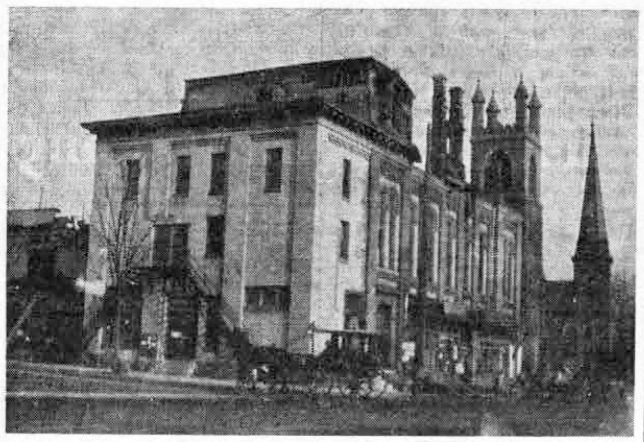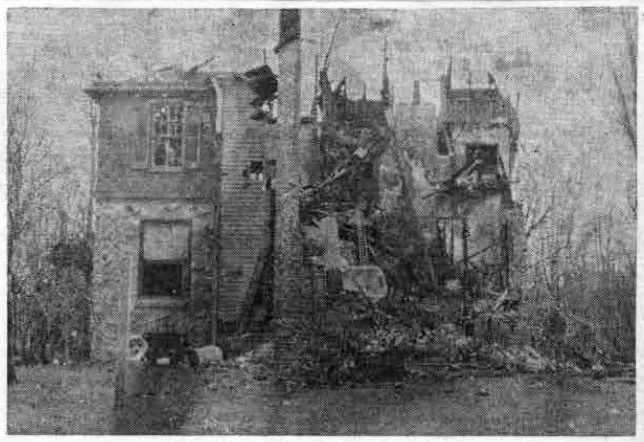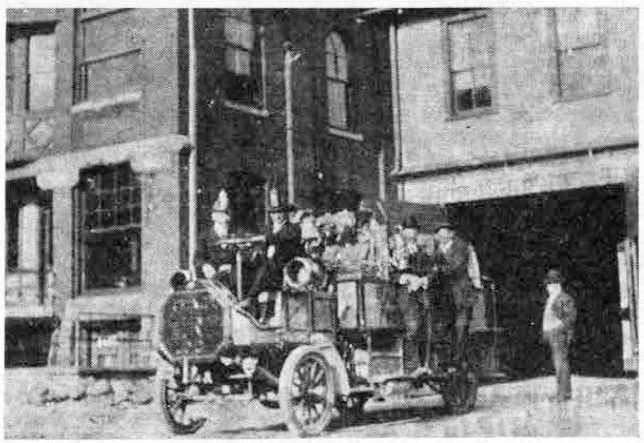 Although the picture shown above does not tell as graphic a story of the 1914 fire in Wayne’s old Lyceum Hall as do several others that have been used in this column, it is otherwise the most interesting picture shown to date of Wayne’s busiest corner 40 years ago.
Although the picture shown above does not tell as graphic a story of the 1914 fire in Wayne’s old Lyceum Hall as do several others that have been used in this column, it is otherwise the most interesting picture shown to date of Wayne’s busiest corner 40 years ago.
This edifice, remodeled several years ago, is now the Colonial Building. The original building, erected on the northeast corner of Lancaster and North Wayne avenues in 1871 by J. Henry Askin, was known as “The Lyceum” and later as the “Old Opera House.”
The horsedrawn vehicle, shown in the foreground of the picture, might well be called the forerunner of our present day station wagon, since a “wagonette” was a four-wheeled carriage designed for pleasure driving, with seating facilities for several persons. There were a number of them in use in Wayne for many years, and interesting examples of both those with a top and without one were shown in this column in April, 1949.
The fire which created such havoc in Wayne’s largest business building broke out about 1:30 A.M. on December 30, 1914, gaining its start in the second floor of the Gas Company’s office, directly adjoining the old Opera House on North Wayne avenue. At that time the Radnor Fire Company had but two engines, which were quickly called into service. Otis Hunsicker, one of the old time firemen, tells your columnist that the first fire engine to be built by the Hale Fire Pump Company of Conshohocken was still in the shop, complete except for paint. So dire was the need for it that it was called into use just as it was, with Charles J. Young in charge of it.
In addition, hurry calls were sent to Berwyn, Devon, Bryn Mawr and Merion No. 1. At one time eight streams of water were playing on the fire, the worst experienced in Wayne since the old Bellevue Hotel burned to the ground in March 1900. Losses from the Opera House fire were heavy, including $30,000 at the real estate firm of Wendell and Treat.
In spite of the destruction wrought throughout the building, extensive repairs were soon under way, with tenants returning to their former quarters with little delay.
 The picture above shows the destruction wrought by fire on February 14, 1912, in the house then occupied by the George W. Hill family at 216 Walnut avenue. A notation on the original picture gives its origin as “hot ashes in outside shed.” Because of engine trouble, there was some delay in the arrival on the scene of Radnor’s two engines. However, they were soon joined by those from the Bryn Mawr Fire Company, who united their efforts with those of the local firemen to save whatever was possible. This included most of the contents of the house, except for some books and papers of Mr. Hill. Mrs. Hill, who was ill at the time, was removed to the home of a neighbor. After some hours of battling the flames the firemen left only to be recalled to the scene at 3 o’clock the next morning when fire broke out again.
The picture above shows the destruction wrought by fire on February 14, 1912, in the house then occupied by the George W. Hill family at 216 Walnut avenue. A notation on the original picture gives its origin as “hot ashes in outside shed.” Because of engine trouble, there was some delay in the arrival on the scene of Radnor’s two engines. However, they were soon joined by those from the Bryn Mawr Fire Company, who united their efforts with those of the local firemen to save whatever was possible. This included most of the contents of the house, except for some books and papers of Mr. Hill. Mrs. Hill, who was ill at the time, was removed to the home of a neighbor. After some hours of battling the flames the firemen left only to be recalled to the scene at 3 o’clock the next morning when fire broke out again.
 Except for the fact that the motor had been changed and a radiator added, the appearance of this first piece of motorized firefighting equipment, as shown in this column two weeks ago, is little changed. Those riding on the truck (left to right) are Ralph Robson, William Bryan, Jack Clark and Charles Watkins.
Except for the fact that the motor had been changed and a radiator added, the appearance of this first piece of motorized firefighting equipment, as shown in this column two weeks ago, is little changed. Those riding on the truck (left to right) are Ralph Robson, William Bryan, Jack Clark and Charles Watkins.
